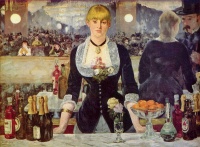Coffeehouse
From The Art and Popular Culture Encyclopedia
(Difference between revisions)
| Revision as of 20:38, 29 November 2018 Jahsonic (Talk | contribs) ← Previous diff |
Revision as of 15:36, 11 November 2019 Jahsonic (Talk | contribs) Next diff → |
||
| Line 12: | Line 12: | ||
| *[[Café de la Paix]] | *[[Café de la Paix]] | ||
| *[[Les Deux Magots]] | *[[Les Deux Magots]] | ||
| - | *[[1001 Nights]] | + | *[[1001 Nights (café in Tangier) ]] |
| *[[Café Certa]] | *[[Café Certa]] | ||
| *[[Hafa Café]] | *[[Hafa Café]] | ||
Revision as of 15:36, 11 November 2019
|
"For Weegee and Brassai alike, the only refuge from the night, the only sanctuary, was in the bars and cafes. Weegee's Montmartre was the Bowery." --"Night Light: Brassai and Weegee" (1976) by Colin Westerbeck |

A Bar at the Folies-Bergère, painted and exhibited at the Paris Salon in 1882, was the last major work by French painter Édouard Manet before he died. It depicts a scene in the Folies Bergère nightclub in Paris, depicting a bar-girl, one of the demimondaine, standing before a mirror.
|
Related e |
|
Featured: |
A café (French for coffee) is a type of cafeteria, often with an enclosed or outdoor section extending onto the pavement or sidewalk, where meals are served.
Notable cafés
- Café de Flore
- Café de la Paix
- Les Deux Magots
- 1001 Nights (café in Tangier)
- Café Certa
- Hafa Café
- Romanic Café
See also
Unless indicated otherwise, the text in this article is either based on Wikipedia article "Coffeehouse" or another language Wikipedia page thereof used under the terms of the GNU Free Documentation License; or on research by Jahsonic and friends. See Art and Popular Culture's copyright notice.
_-_Edgar_Degas.jpg)

